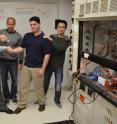TSRI chemists devise powerful new method for modifying drug molecules
Chemists at The Scripps Research Institute (TSRI) have developed a versatile new technique for making modifications--especially one type of extremely difficult, but much-sought-after modification--to complex drug molecules. The feat, reported in the January 15 issue of the journal Science, has already enabled pharma giant Pfizer to proceed with the evaluation of a promising cancer drug candidate that otherwise could not have been made in sufficient quantities.
"People from other pharma companies who have seen early drafts of this paper can't get their hands on the supporting information fast enough," said senior investigator Phil S. Baran, the Darlene Shiley Professor of Chemistry at TSRI. "I expect that every company in the business of making drugs will be using this chemistry soon."
The technique, known as "strain-release amination," also should enable the easier construction of a variety of molecules besides pharmaceuticals, including molecular probes for basic biology studies, plastics, and other materials made from organic compounds.
Pfizer's Bottleneck
The project began with Pfizer's request for help in synthesizing a molecule known as bicyclo[1.1.1]pentan-1-amine, which it needed to make the cancer drug candidate. The Baran laboratory frequently collaborates with Pfizer and other pharma companies to solve tough problems in medicinal and process chemistry.
Traditional methods of synthesizing bicyclo[1.1.1]pentan-1-amine left much to be desired. "Most of the previously published synthetic routes require three to five steps with toxic reagents and yield only tens of milligrams," said Ryan Gianatassio, a PhD student at TSRI who was co-first author of the study.
Pfizer needed kilograms of bicyclo[1.1.1]pentan-1-amine for preclinical studies of its cancer drug candidate, and the company had had to shelve the drug's development until it could make that much of it.
"We built a team of expert synthetic chemists to solve this challenging problem, including chemists from Phil Baran's lab and Pfizer's synthetic and process chemistry groups," said Michael R. Collins, a senior principal scientist at the drug company's La Jolla Laboratories.
Baran and his team, including Gianatassio and co-first author TSRI Research Associate Justin M. Lopchuk were able to solve the supply problem for this building block, enabling a relatively quick and easy synthesis from a readily available starting compound. "Using our procedure, Pfizer easily produced over 100 grams, and they are now in a position to scale that up further and re-start that delayed drug development program," said Gianatassio.
Adding Strained-Ring Structures
Baran realized that the new method could have much broader applications.
Bicyclo[1.1.1]pentan-1-amine is a "spring-loaded" or "strained ring" molecule, in which carbon atoms are arranged in rings at odd angles, with relatively large bond energies. Pharmaceutical chemists know that adding such a structure to a drug molecule sometimes greatly improves the drug's properties: making it more absorbable by the gut, for example, or enabling it to resist breakdown by enzymes in the body so that it works therapeutically for longer periods.
The problem has been that, using traditional methods, the insertion of these small structures into larger drug molecules is tricky--so much so that chemists often have had to redesign the entire synthesis around the small added structure.
"The way they've been doing it is like decorating a Christmas tree by putting the ornaments in place first and then growing the tree around it," said Baran. "In many cases they just won't pursue that because of the time and labor it would take."
Baran and his team showed that they could use their new method to directly append a strained-ring molecule favored by pharmaceutical chemists--propellane, so-called because its structure resembles a propeller--to existing larger drug molecules. "We can make that five-carbon ring structure of propellane click onto a wide range of drug molecules of a type known as secondary amines--we call that a propellerization reaction," said Lopchuck.
"In fact, starting with a stock solution of the propellane, we can use high-throughput techniques to quickly elaborate a matrix of amine-containing compounds with the bicyclopentyl moiety, instead of painstakingly synthesizing the compounds one at a time," Collins said.
The team went on to demonstrate similar direct modifications using two other strained-ring structures, azetidine and cyclobutane.
The TSRI researchers also found that they could use the new method to attach molecules very precisely and selectively to specific amino acids on proteins, thus in principle enabling the creation of new biologic drugs as well as new reagents that would be useful in basic biology research. "This technique opens up a world of chemistry that academic and commercial laboratories have really wanted to look into but couldn't, due to the technical obstacles," said Baran.
The supporting, publicly available information on strain-release amination is meant to enable chemists to start using the technique right away. A behind-the-scenes account and high-definition photos of the new reaction setup can be found on the Baran Lab Blog, Open Flask.
"This can be considered rapid bench to bedside chemistry because it is fundamental science that will have a positive impact on human medicine in a short period of time," Baran said.
Source: Scripps Research Institute
Articles on the same topic
- TSRI researchers develop versatile new way to build moleculesFri, 15 Jan 2016, 10:07:47 UTC
Other sources
- Chemists devise powerful new method for modifying drug moleculesfrom Science DailyFri, 15 Jan 2016, 10:04:10 UTC
- Versatile new way to build molecules developedfrom Science DailyFri, 15 Jan 2016, 10:03:45 UTC
- Researchers develop versatile new way to build moleculesfrom PhysorgThu, 14 Jan 2016, 19:16:14 UTC
- Chemists devise powerful new method for modifying drug moleculesfrom PhysorgThu, 14 Jan 2016, 19:15:49 UTC
